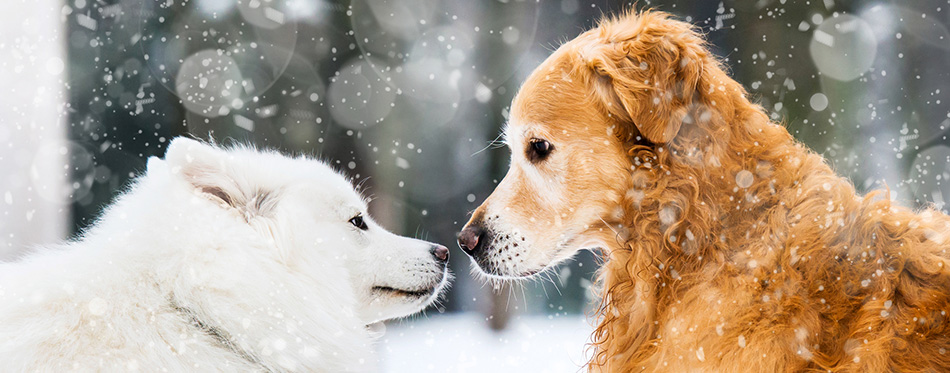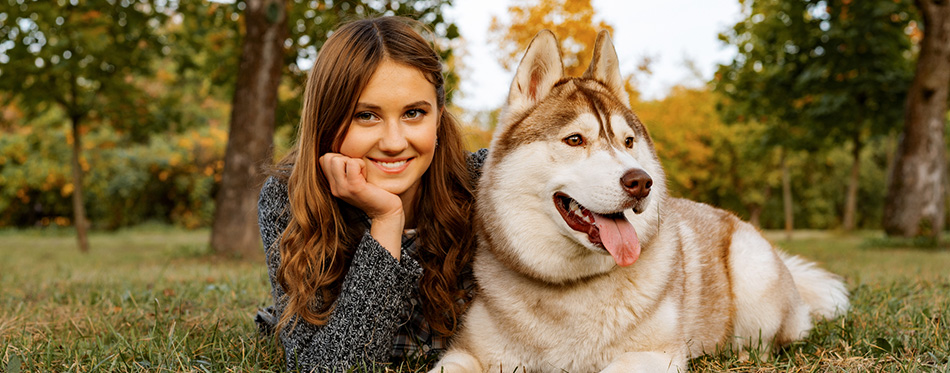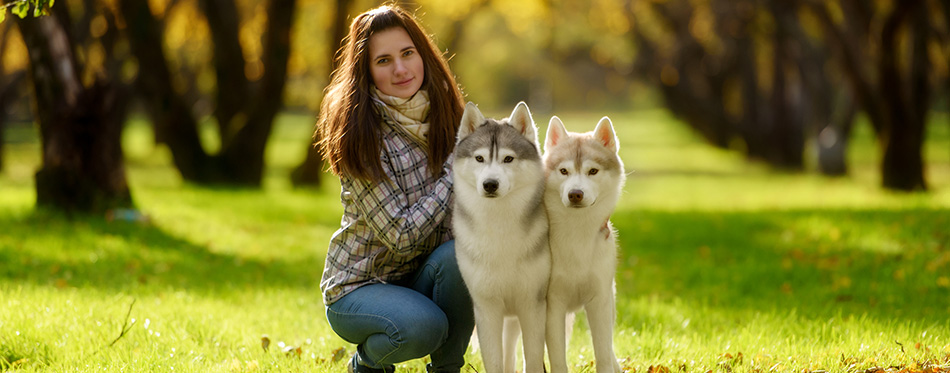Playful, affectionate, and very friendly. They’re excellent guide dogs, therapy dogs, and superb family companions. They are highly obedient and maybe even smarter than your neighbor. Best of all, the love and appreciation they will shower you with are simply incomparable. Now, who wouldn’t want such a dog for their family even if it means it is not really a purebred? We’re talking about the Husky Lab (also known as the Siberian Retriever), of course. And if you think you’d want this hybrid for your family, you’d better keep reading to find out more.
History of the Siberian Retriever
Before anything else, let’s just clarify something about the Husky Lab mix. You can call it the Siberian Retriever or even the Huskador, but you should never call it “Labrador Husky” as this is a purebred dog that was developed in AD 1300 by the Thule Inuit people. It is a purebred dog while the Husky Lab or Siberian Retriever is a hybrid or a crossbreed. However, there are quite a number of Husky Labs that do look a lot like the purebred Labrador Husky. So be careful.
While we can trace the history of the Labrador Husky to 13th to 14th century Inuits, the Siberian Husky to 3000 BC Chukchis, and the Labrador retriever to 19th century England (although the Lab’s direct ancestor is from Newfoundland in Canada), there is no credible information as to when the Husky Lab was first crossbred or who hybridized it or where.
What we do know is that in the later part of the 20th century, specifically in the 1990s, there was a growing interest in the creation or designing of crossbreed dogs. It is thus safe to say that the Husky Lab was also developed during this period by some chap who may have wanted the speed, agility, and endurance of the Siberian Husky and the intelligence, good temperament, and trusting nature of the Labrador retriever.
Who knows what the reason is? We’re just glad that the Siberian Retriever was created at a time when people are looking for a truly loyal and loving dog they can easily bring home and become part of their growing family.

Who are the Parents?
Crossbreeding doesn’t always result in a perfect 50-50 split of the desirable traits one would want from each parent breed. Like they always say, with a purebred you’re almost always certain of what you can expect; with a hybrid this certainty is a guess at best. To gain a better understanding of how your Siberian Retriever may turn out to be, let’s have a look at its purebred parents first.
Labrador Retriever
A direct descendant of Newfoundland, Canada’s St. John’s water dog, the Labrador retriever is a well-loved breed. As a matter of fact, it has won the hearts of more people than any other breed in the US as well as the UK and Canada.
The Lab, as folks fondly call this breed, is quite famous for its tractable, kind, outgoing, and pleasant nature. They have this even temperament that makes them the perfect example of what a family dog should be. Their reputation with children is rarely matched; very few dogs can be given the child-friendly badge. And if they are good with kids, they’re even better with other dogs and animals. They have this certain aura in them that turns them into four-legged social magnets.
It is this gentle nature of Labs that make them excellent service dogs, especially as therapy dogs. They are easily trained as they’re gifted with the correct wirings of the brain to understand what their human trainer wants them to accomplish. They are the four-legged eyes and ears of the blind and the deaf, respectively. Even when not helping their disabled masters navigate the busy, chaotic city streets, the Lab won’t mind sitting beside its master if it’s the only way it can bring comfort to a troubled soul.
Now, don’t think that the Lab is a softy; it isn’t. The original Lab was bred to work, not to be pampered by its family. They are not scent hounds, yet when they are at work they can easily lock onto a particular scent and won’t stop until they’ve uncovered the source of the scent. It is for this reason that these dogs are highly-revered by members of the uniformed services. Many have served in Iraq and Afghanistan as well as other areas of conflict. They’re prized for their hunting and sporting skills as well.
Check out our guide on Dog Food for Labs.
Siberian Husky
The Siberian husky was developed by the Chukchi people of Siberia some 5,000 to 8,000 years ago. They share their ancestry of the Taymyr wolf with the Alaskan Malamute and the Samoyed, giving them that distinct wolf-like appearance.
Bred for its speed, agility, and endurance as a racing sled dog, the Husky is the go-to Arctic canine of hunters who have to travel light over greater distances to bring that much-needed resources for the family and the larger community. These dogs are known for their relentless spirit amidst adversity.
When not pulling sleds and racing with other sled dogs, the Siberian Husky enjoys the company of children especially when allowed to play with them. After all, this dog surely can make use of a good R&R after a grueling season in the snow. And Chukchi kids were more than happy to oblige. Additionally, the dense double coat of the Husky gave children extra-warmth when cuddled next to a Husky; although we clearly don’t recommend doing this with your kid without your active supervision.
There’s no doubt about the Husky’s passion and love for life. It’s forever affectionate and happy, made even happier if it can be given the work that it really needs. It may have the facial features of a wolf, but its eyes are forever gleaming with pride, often overflowing with confidence in what it can bring to its human family.
Intelligent yet stubborn, the Siberian Husky is never for a newbie dog owner or one who doesn’t know how to handle a hound with a rather strong personality. It can be gentle, yes; but its stubborn streak can test even the most seasoned dog trainer. But once you win its loyalty, you’ll forever be thankful to the loyalty, obedience, and friendship that the Husky can bring.

Quick Facts
It would definitely be interesting to know just what kind of dog crossbreeding a gentle and even-tempered Lab with a rambunctious yet loyal Siberian Husky will bring. As we have already pointed out, there’s no way we can ever guarantee that your Husky Lab will have the same exact characteristics of the Siberian Retriever of your neighbor or friend. Because they are of different breeds, the variations in their physical characteristics, behaviors, and temperaments can be great. However, we can still generalize some things about the Husky Lab.
- The Husky Lab is classified as a medium or large dog depending on the size of its parents.
- Males can grow between 21 and 25 inches while females can be anywhere from 20 to 24 inches.
- Males weigh around 45 to 60 pounds while female Husky Labs tip the scale at 40 to 55 pounds.
- The Husky Lab can reach full maturity at the age of 18 months.
- Siberian Retrievers can live up to 15 years, although some may live longer.
- The coat of the Siberian Retriever can be colored black, white, cream, brown, or gray and can be described as short to medium in length and above-average in density. The coat is straight, never wavy, curly, wiry, or even corded.
- The Siberian Retriever is not hypoallergenic since it sheds a lot.
- The body of a Husky Lab is athletic and strong complete with a curled and pointed tail.
- It has a very high activity level requiring at least 14 miles of walking per week and 60 minutes of intense exercise and playtime every day.
- The Siberian Retriever is recognized only by the Dog Registry of America.
Things You Should Know
The Siberian Retriever can be a venerable pet for the family, but there are clearly certain things that you have to know and understand before bringing one home.
Training
As long as you can consider yourself a pack leader, training the Siberian Retriever should never be a problem. This is especially true if you have a Husky Lab with more Siberian Husky in its blood than its Labrador parent. As such, we don’t really recommend a novice dog owner to bring home a Husky Lab.
Training a Siberian Husky can be very challenging even to a seasoned trainer, not because the dog is not smart but because it has a high level of independent thinking. On the other hand, the Labrador is quite easy to train primarily because of its eagerness to please its human masters. Combine the two and you should have a moderately-easy to train Husky Lab. The point here is that when it comes to intelligence, both the Lab and the Husky are smart. However, one is motivated by attention while the other is by recognition of who’s the leader.
Regardless of your Husky Lab’s motivation, positive reinforcement training techniques work best. Be firm and assertive yet kind and gentle, too. It’s all about finding the correct balance between firmness and gentleness so your dog will follow you.
Related Post: Dog Training Books
Feeding
Since the Husky Lab can be classified as a medium- to large-sized dog, it is crucial to feed it according to its weight. You can easily determine this by first converting its weight from pounds to kilograms and then raising the result to the ¾ power. Next, multiply 70 to get your Husky Lab’s resting energy requirements. From this value, you will need to multiply the appropriate factor.
For example, you have an unneutered Siberian Retriever that weighs 50 pounds or 22.7 kilograms. We’ll raise 23 kilograms to the ¾ power to get 10.5 then multiply it by 70. The resting energy requirement of your Husky Lab is 735 calories per day. But since it is unneutered with normal levels of activity, then we’ll multiply the 735 by 1.6 to get 1,176 calories per day. You can then do your math to divide the number of cups you need to give to your Husky Lab depending on the calorie serving size of your high-quality dog food. Obviously, the more active your Husky Lab is the more calories it needs.
For more guides on choosing the right dog food, you may wish to check out our reviews of the best dry dog food, organic dog food, grain free dog food, food for diabetic dogs and cheap dog food.
Exercise
As we mentioned in the facts about the Husky Lab, a typical grownup Siberian retriever requires at least 14 miles of weekly walking or an average of 2 miles per day. Another way of saying it is that a Husky Lab will want you to exercise it for a minimum of 60 minutes every single day.
The good news is that it doesn’t have to be all walk or exercise per se. You can engage your pet in physically demanding games or playtime activities. For example, you can play ball fetch or Frisbee or even engage in swimming activities. Biking, cart pulling, or even kiddie wagon-pulling can be a great way to spend the excess energy of your Husky Lab. For a wider selection of choices, check out our dog ball launchers and dog frisbees guides.
Remember these crossbreeds have very high levels of energy. If you don’t provide more constructive activities for your Siberian Retriever it will find a way to dispense of this energy through more destructive means.
Socialization
Both the Lab and the Siberian Husky are well-revered by their respective families. It shouldn’t be a problem for a Siberian Retriever to be well-loved by its family, too. However, there is still a tendency that the Husky Lab can become overprotective of its family as well as their belongings. In such cases, it may not be especially friendly to other dogs and even to other people.
Socializing your Husky Lab puppy as early as possible can help address such problems. Taking it to the dog park or perhaps even inviting friends with their respective dogs for a weekend of man-dog interaction should be great. We really have to point out that a dog’s friendliness should never be taken for granted; it should be nurtured right from the beginning.
Grooming
The Siberian Retriever may have relatively short to medium length coat, but it is not exactly a low-shedding type of dog either. For many pet parents, this hybrid can shed a lot. As such you should always get your vacuum cleaner ready for those instances when the Husky Lab is ready to blow. A better approach is to use a deshedding brush. It won’t prevent shedding, but it can help minimize pet hair on your surfaces.
The other aspects of grooming like clipping the nails, brushing the teeth, and cleaning and inspecting the ears are pretty basic and should be observed at regular intervals. If you’re not keen on giving the Husky Lab a good grooming session, then be prepared to take it to a professional dog groomer every 2 to 3 months at least.
For more help on dog grooming, you may wish to read our guides on the best dog nail grinders, dog dryers, dog clippers, dematting tools for dogs and dog ear cleaners.

Health
Eye problems, hip dysplasia, and skin diseases are the major concerns of Husky Labs. They are also quite prone to arthritis and degenerative myelopathy. It is important to check its parents for any history of canine problems that may have a genetic link. If there are it’s up to you whether to take the Husky Lab or not. If you still wish to bring it home, then be prepared to manage these conditions with your vet.
We strongly recommend the Siberian Retriever to anyone who:
- Is already a pet parent and who understands the unique requirements of a Husky Lab especially in terms of socialization and training
- Has kids at home, but preferably older than 5 years old
- Can walk or exercise their dog at least 60 minutes everyday
- Can play with their dog at least 60 minutes everyday
- Doesn’t mind brushing the coat and vacuuming the surfaces of the home every day
- Is a ‘pack leader’
Sadly, the Husky Lab is not for you if you:
- Have allergies, especially pet dander allergies
- Are relatively new to pet ownership, especially with regards to training and socialization of dogs
- Are a couch potato, preferring instead to lead a sedentary lifestyle than an active one
- Absolutely hate grooming, socializing, training, and exercising a dog
- Need to be away from home and leave your dog for long periods of time
Temperament
Intelligent, patient, energetic, loyal, curious, and affectionate. These are what best describes the Husky Lab. It’s an interesting mix of a Siberian Husky’s outgoing personality and a Labrador retriever’s mild-tempered nature. Both are gentle and can be exceptionally friendly with kids, making the Siberian Retriever equally good at taking care of children. Because of their natural tendency to be extremely attached to their human family, it is not uncommon that Husky Labs can suffer from severe separation anxiety as well as other doggie behavioral issues. Like all breeds of dogs, training and socialization plus high-quality nutrition are a must if you want your Husky Lab to grow into a well-rounded hound.
The Husky Lab, they say, is one of the best crosses you can ever find in the ever-growing designer dog market. But before you decide to bring one home, make sure that you’re more than prepared to take on the many challenges of a hybrid dog.

